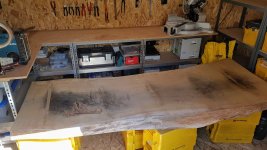I know this topic has been discussed quite some time already, but i am a bit hesitant to 'just buy the biggest machine' and return it if it doesn't fit me. I have a RTS 400 which i use to sand in general and i have a CTL-MINI as well.
Regardig the weight of the machines; if i sand, it are mainly flat surfaces or i would be OK to lay the work flat before finishing it. I think it will be rarely that i have to sand a piece of furniture in the vertical way.
I need to sand my oak tabletop which i've bought, and doing it with the RTS 400 is a PITA to be honest. Here are 2 pics of it:
[attachimg=1]
[attachimg=2]
On this side of the table-top it is like taking of max 1 mm of the entire surface, on the other side there is a slight curve, which would mean taking of 3-5 mm in the middle of the slate. I am expecting that this will be my only tabletop i will ever create. The rest of the works i will be doing are either douglass wood, or MDF furnitures or wooden doors etc.
What type of device would you advise for me? I've watched the videos of [member=15022]parfait3[/member] but i am a bit inconclusive
Regardig the weight of the machines; if i sand, it are mainly flat surfaces or i would be OK to lay the work flat before finishing it. I think it will be rarely that i have to sand a piece of furniture in the vertical way.
I need to sand my oak tabletop which i've bought, and doing it with the RTS 400 is a PITA to be honest. Here are 2 pics of it:
[attachimg=1]
[attachimg=2]
On this side of the table-top it is like taking of max 1 mm of the entire surface, on the other side there is a slight curve, which would mean taking of 3-5 mm in the middle of the slate. I am expecting that this will be my only tabletop i will ever create. The rest of the works i will be doing are either douglass wood, or MDF furnitures or wooden doors etc.
What type of device would you advise for me? I've watched the videos of [member=15022]parfait3[/member] but i am a bit inconclusive


